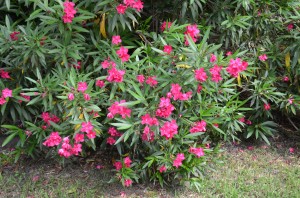Oleander (Nerium oleander) is an attractive evergreen shrub for warm climates. Indigenous to the Mediterranean region, it is popular in warm regions of the U.S., namely in western, coastal, and southern states (USDA hardiness zones 8-11).
Oleander prefers moist, well-drained soil and a sunny landscape site. Established shrubs withstand dry and windy conditions along coastal areas. Brightly colored flowers, depending on variety, range from red, purple, pink, lilac, salmon, yellow, and white. A few flaunt variegated foliage. Oleander blooms in spurts from late spring to early fall.
Oleanders grow 8-15 feet in height and 5-10 feet in width. Some cultivars can be trained into small trees which may get 20-25 feet tall. Overall floral fragrance differs from one plant to the next.
Plant nursery-grown container plants in spring, summer, or fall. For a hedge space oleanders 6 to 12 feet apart, depending on cultivar size and vigor. Water plants during the summer if weekly rainfall falls below 1- inch.
Prune oleander immediately following its main bloom period to encourage bushier shrubs, more flowers, and to reduce size. Use caution around children and pets, as all parts of oleanders are highly poisonous; plant sap causes skin irritation to some individuals.
Most oleanders are vigorous growers and grow equally well in containers. In northern areas oleander is treated as a winter house plant; repot plant(s) in fresh media (soil) and set into a larger container. Overwinter this frost-tender plant by bringing it indoors when fall temperatures drop below 45°F at night. Some varieties are hardier than others. Prune plant back hard before bringing into a sunny room for the winter.
Aphids and scale are occasional nuisance pests and oleanders are deer resistant.


 Posted in
Posted in 
